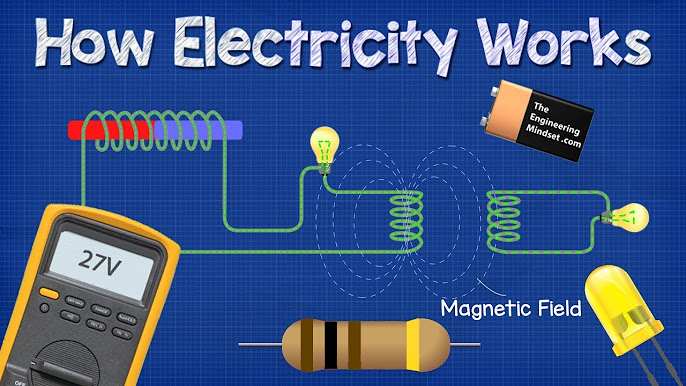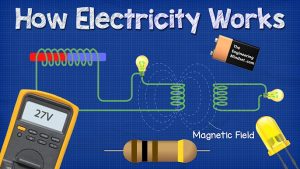Electrical Engineering Basics: Foundations That Power the Modern World
Explore the fundamentals of electrical engineering—from voltage and current to circuits and safety. Learn key concepts, real-world applications, and future trends in this dynamic field.
Introduction: How Does Electricity Power Our World?
From lighting our homes to powering smartphones and driving electric vehicles, electrical engineering plays a central role in modern life. But what are the basic principles that make it all work? Whether you’re a beginner, student, or professional brushing up, understanding the core concepts of electrical engineering is vital.
What Is Electrical Engineering?
Electrical engineering is the field that deals with the study and application of electricity, electronics, and electromagnetism. It forms the backbone of countless technologies, including power generation, communication systems, automation, and electronics.
Key Concepts in Electrical Engineering
🔌 1. Voltage, Current, and Resistance
-
Voltage (V): The electric potential difference between two points
-
Current (I): The flow of electric charge (measured in Amperes)
-
Resistance (R): Opposition to current flow (measured in Ohms)
Ohm’s Law: V = I × R
🧭 2. Electrical Circuits
-
A combination of resistors, capacitors, inductors, and sources (batteries/generators)
-
Can be series, parallel, or complex circuits
⚡ 3. AC vs. DC Power
-
AC (Alternating Current): Used in homes and industries (e.g., 230V, 50Hz)
-
DC (Direct Current): Found in batteries, electronics, and solar systems
⚙ 4. Power and Energy
-
Power (Watts): Rate of doing electrical work → P = V × I
-
Energy (kWh): Total electrical energy consumed over time
Practical Applications
- Home Wiring & Appliances
- Electric Motors and Generators
- Lighting Systems
- Control Systems & Automation
- Telecommunications and Data Transmission
Safety in Electrical Engineering
- Always turn off power before working on circuits
- Use insulated tools and PPE
- Understand grounding, circuit breakers, and fuses
- Follow IEC and OSHA standards
Emerging Trends
- Renewable Energy Integration (solar, wind)
- Electric Vehicles and Charging Infrastructure
- Smart Grids and IoT in Power Systems
- Energy Storage and Battery Technologies
- Wireless Power Transfer
FAQs
Q: What are the most important basics to learn in electrical engineering?
A: Ohm’s Law, circuit theory, AC/DC, safety, and power systems are foundational.
Q: Can I self-learn electrical engineering?
A: Yes, through books, YouTube tutorials, and online platforms like Coursera or MIT OpenCourseWare.
Q: What’s the difference between electrical and electronic engineering?
A: Electrical focuses on large-scale power systems; electronics focuses on small-scale circuits (e.g., microcontrollers).
Conclusion: Empowering Innovation with Electricity
Electrical engineering is all around us—from the smallest circuits to the biggest grids. Mastering its basics opens the door to innovation, safety, and sustainable design in every sector.
👉 Learn more at All About Circuits, Electrical4U, and IEEE.
Electrical Engineering Basics in the Maritime Industry: Powering Ships and Port Systems
Learn the basics of electrical engineering as applied to ships and ports—covering generators, switchboards, automation, and safety for maritime professionals and engineers.
Introduction: What Keeps a Ship Running—Beyond the Engine?
Modern ships are floating cities—with their own power plants, distribution systems, and automation controls. Behind the scenes, electrical engineering ensures that navigation systems, lighting, machinery, and communication devices all function reliably. For seafarers and maritime engineers, understanding the basics is essential.
Core Electrical Concepts for Maritime Professionals
⚡ 1. Shipboard Power Systems
-
Generators (diesel alternators or shaft generators) produce AC power
-
Distribution via main switchboards, transformers, and circuit breakers
-
Frequency often 60 Hz (vs. 50 Hz onshore), with voltages like 440V or 220V
🔧 2. AC and DC Loads
-
AC Loads: HVAC systems, pumps, lights, radar, winches
-
DC Loads: Emergency lights, batteries, control circuits
⚙ 3. Emergency Power Systems
-
Vital for safety equipment (fire pumps, GMDSS, emergency lighting)
-
Supplied by emergency generators or batteries
🔍 4. Electrical Safety at Sea
-
Insulation monitoring
-
Earth fault detection
-
Explosion-proof systems in hazardous areas (e.g., tankers)
-
Periodic testing using megger (insulation resistance) and multimeter
Examples of Onboard Electrical Equipment
-
Motor Starters for cargo pumps and ventilation
-
Variable Frequency Drives (VFDs) for energy efficiency
-
Engine Room Monitoring Systems (automated alarms, control panels)
-
PLC & SCADA Systems in modern ships for automation
Electrical Roles in Maritime Careers
| Role | Responsibility |
|---|---|
| Electro-Technical Officer (ETO) | Maintains electrical/electronic systems |
| Third Engineer | Assists with generator operations and motor repairs |
| Shore Electrician | Handles port crane systems and shore power setups |
| Marine Superintendent | Oversees electrical inspections and compliance |
Training and Standards
-
STCW Code Section A-III/6: For ETOs and electrical safety
-
DNV & ABS Guidelines: For shipboard electrical systems
-
Class Inspections: Annual checks of insulation, grounding, load tests
Case Study: Preventing a Blackout at Sea
During a ballast operation, a bulk carrier experienced a sudden main switchboard overload. Thanks to proper generator load sharing settings and ETO intervention, the crew prevented a full blackout—a reminder that electrical awareness is essential for safety and continuity.
Latest Trends in Maritime Electrical Engineering
-
Hybrid & Electric Propulsion
-
Shore Power (Cold Ironing) to reduce emissions in port
-
Digital Twin Systems for predictive maintenance
-
Energy Efficiency Systems integrated with vessel automation
-
Cybersecurity for Critical Infrastructure (power systems included)
FAQs
Q: Do seafarers need to understand electrical systems?
A: Yes. Even non-ETOs must understand basic systems for operations and safety.
Q: What certifications help in maritime electrical roles?
A: STCW Electrical Safety, HV Course, PLC training, and Marlins Technical English.
Q: How is maritime electrical engineering different from land-based systems?
A: Maritime systems must be compact, vibration-resistant, and suited for variable loads and isolation from shore grids.
Conclusion: Lighting the Future of Maritime with Electrical Expertise
From powering radar to ensuring crew safety, electrical engineering is the heartbeat of modern ships. For maritime professionals, mastering these concepts not only enhances competence—it empowers careers at sea and ashore.
👉 Learn more at IMO Training Guidelines, Marine Insight Electrical Articles, and DNV Electrical System Rules.


